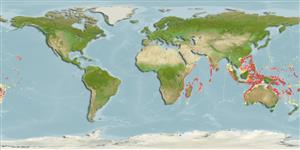Classification / Names
Common names from other countries
Main reference
Size / Weight / Age
Max length : 35.0 cm SL male/unsexed; (Ref. 559); common length : 30.0 cm TL male/unsexed; (Ref. 43448)
Environment
Marine; benthopelagic; depth range 50 - 1000 m (Ref. 112463), usually 100 - 800 m (Ref. 559)
Climate / Range
Deep-water, preferred 27°C (Ref. 107945); 23°N - 36°S, 19°E - 154°W
Distribution
Short description
Dorsal
spines
(total): 10;
Dorsal
soft rays
(total): 9;
Anal
spines: 2;
Anal
soft rays: 7;
Vertebrae: 25. Body elongate, compressed, with large cycloid scales. Body uniformly blackish-brown in young, black dorsally, paler ventrally in adults. Distinguished by its anal fin element counts, lack of fin spine with serration on the anterior edge, and 3 to 6 large canine-like teeth on lateral side of the lower jaw.
IUCN Red List Status (Ref. 115185)
Threat to humans
Harmless
Human uses
Fisheries: commercial
More information
ReferencesAquacultureAquaculture profileStrainsGeneticsAllele frequenciesHeritabilityDiseasesProcessingMass conversion
Tools
Special reports
Download XML
Internet sources
Estimates of some properties based on models
Phylogenetic diversity index
PD50 = 0.5001 many relatives (e.g. carps) 0.5 - 2.0 few relatives (e.g. lungfishes)
Trophic Level
4.3 ±0.73 se; Based on food items.
Resilience
Medium, minimum population doubling time 1.4 - 4.4 years (Assuming tm=4)
Vulnerability
Moderate vulnerability (45 of 100)
Price category
